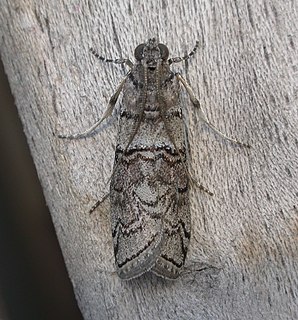Related Research Articles

Kookaburras are terrestrial tree kingfishers of the genus Dacelo native to Australia and New Guinea, which grow to between 28 and 42 centimetres in length and weigh around 300 grams. The name is a loanword from Wiradjuri guuguubarra, onomatopoeic of its call. The loud distinctive call of the laughing kookaburra is widely used as a stock sound effect in situations that involve an Australian bush setting or tropical jungle, especially in older movies.

Bandicoots are a group of more than 20 species of small to medium-sized, terrestrial marsupial omnivores in the order Peramelemorphia. They are endemic to the Australia–New Guinea region, including the Bismarck Archipelago and, marginally, in Indonesia (Seram).

Syzygium is a genus of flowering plants that belongs to the myrtle family, Myrtaceae. The genus comprises about 1200–1800 species, and has a native range that extends from Africa and Madagascar through southern Asia east through the Pacific. Its highest levels of diversity occur from Malaysia to northeastern Australia, where many species are very poorly known and many more have not been described taxonomically.

Acacia, commonly known as the wattles or acacias, is a large genus of shrubs and trees in the subfamily Mimosoideae of the pea family Fabaceae. Initially, it comprised a group of plant species native to Africa and Australasia, but is has now been limited to contain only the Australasian species. The genus name is New Latin, borrowed from the Greek ἀκακία (akakia), a term used by Dioscorides for a preparation extracted from the leaves and fruit pods of Vachellia nilotica, the original type of the genus. In his Pinax (1623), Gaspard Bauhin mentioned the Greek ἀκακία from Dioscorides as the origin of the Latin name.
The Namoi River snapping turtle, also commonly known as Bell's turtle, the Namoi River elseya, or Bell's saw-shelled turtle, is a species of turtle in the family Chelidae. The species is endemic to New South Wales, Australia.

Ovalipes australiensis is a species of crab found in southern Australia. Its range extends from Western Australia to Queensland, including Tasmania. It is fished commercially and recreationally, although it is not as important as the blue swimmer or mud crab.

Ctenomeristis almella is a species of moth of the family Pyralidae. It is found in Australia.
The Myuchelys is a genus of turtles, the Australian saw-shelled turtles, in the family Chelidae and subfamily Chelodininae. They inhabit the headwaters and tributaries of rivers within their range and this led to the name Myuchelys, which is formed from the Aboriginal word myuna meaning clear water and the Greek chelys meaning turtle. They have a short neck and the intergular scute completely separates the gular scutes. They have no alveolar ridge separating them from the snapping turtles of the genus Elseya.

Persoonia levis, commonly known as the broad-leaved geebung, is a shrub native to New South Wales and Victoria in eastern Australia. It reaches 5 m (16 ft) in height and has dark grey papery bark and bright green asymmetrical sickle-shaped leaves up to 14 cm (5.5 in) long and 8 cm (3.2 in) wide. The small yellow flowers appear in summer and autumn, followed by small green fleshy fruit, which are classified as drupes. Within the genus Persoonia, it is a member of the Lanceolata group of 58 closely related species. P. levis interbreeds with several other species where they grow together.

Ctenomeristis is a genus of small moths belonging to the snout moth family (Pyralidae). They are part of the tribe Phycitini within the huge snout moth subfamily Phycitinae.
Ctenomeristis ebriola is a species of snout moth in the genus Ctenomeristis. It was described by Edward Meyrick in 1934 and is known from Sri Lanka.
Ctenomeristis kaltenbachi is a species of snout moth in the genus Ctenomeristis. It was described by Rolf-Ulrich Roesler in 1983 and is known from Sumatra, Indonesia.
Ctenomeristis ochrodepta is a species of snout moth in the genus Ctenomeristis. It was described by Edward Meyrick in 1929, and is known from the Marquesas islands and Sumatra (Indonesia). This species has a wingspan of 15–17 mm.
Ctenomeristis paucicornuti is a species of snout moth in the genus Ctenomeristis. It was described by Marianne Horak in 1998 and is known from western Australia.
Ctenomeristis shafferi is a species of snout moth in the genus Ctenomeristis. It was described by Marianne Horak in 1998 and is known from western Australia.
Ctenomeristis subfuscella is a species of snout moth in the genus Ctenomeristis. It was described by George Hampson in 1901 and is known from Queensland, Australia.
Ctenomeristis vojnitsi is a species of snout moth in the genus Ctenomeristis. It was described by Roesler, in 1983, and is known from Indonesia (Sumatra).
Pinkfloydia is a genus of small Australian long-jawed orb-weavers, reaching a maximum lengths of about 4.5 millimetres (0.18 in). It was first described by D. Dimitrov & G. Hormiga in 2011, and contains two species, found in New South Wales and Western Australia: P. harveyi and P. rixi. They have a unique rounded, cone-shaped head structure with one pair of large eyes and three pairs of smaller eyes. The genus is named after British rock band Pink Floyd.
Myrabolia is the only genus in the beetle family Myraboliidae. It has about 13 species, found in Australia.
References
- ↑ Nuss, M.; et al. (2003–2011). "GlobIZ search". Global Information System on Pyraloidea. Retrieved September 29, 2011.
- ↑ "A reassessment and review of the Australian genus Ctenomeristis Meyrick (Lepidoptera: Pyralidae: Phycitinae)". Ingentaconnect.com. 1997-01-01. Retrieved 2011-12-16.
| This Phycitini-related article is a stub. You can help Wikipedia by expanding it. |